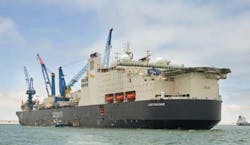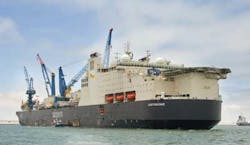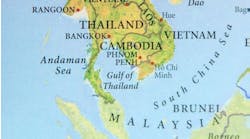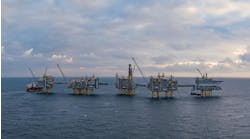View Article as Single page
Blinco further explained that "while we could have engineered a solution to span the escarpment, we decided on a different route, providing a solution which satisfied the necessary robustness for operating a hydrocarbon pipeline for the full development life. It's an asset that needs to operate without any compromise for the 40-year life span of the Ichthys development. Also, the project is a first for Inpex as an operator, so we adopted a conservative approach."
The shallow-water lay barge is an anchored vessel which works outside of the cyclone season. "This mitigates risk associated with cyclone avoidance because of the slow response time typical of anchored vessels. She will have a 12-point anchored mooring system that she uses to navigate her way along the pipeline route," said Blinco. "The deepwater pipelay vessel is a newbuild and quite unique. She can actually pre-fabricate triple joints inside the vessel hold before transferring them into the firing line for final welding into the pipeline. It's a big ship-shaped vessel, with capacity for 700 people and as big as an aircraft carrier. It's extremely efficient with much of the process automated. Because she's so big, she can't work in shallow water, hence the other barge."
Pipeline construction in Darwin involves winching onshore at the landfall site via a 3-km shore-pull, employing buoyancy tanks, roller boxes, and a 600-metric ton (661-ton) linear winch. After roughly 120 km (75 mi) of pipelay with the shallow-water lay barge, the pipeline will be transferred to the deepwater pipelay vessel via industry standard abandonment and recovery procedures. The pipeline will then be laid all the way to the Ichthys field before terminating with the world's largest subsea driverless connector incorporated into a pipeline end termination assembly.
Topside design strategy
Ichthys LNG project director for offshore, Claude Cahuzac, says the CPF is designed to stay on site without dry dock for 40 years: "This is taken into account in our design specifications but also in the lay out of the hull where any part is accessible and can be inspected. All equipment on board has been specified for 40 years. Lay-out and topsides design as well as the redundancy of the equipment allows for maintenance and replacement without production shut down," he added.
"In the Northern Territory and offshore from the Kimberley region the number of cyclones and strength is well known," Cahuzac observed. "But here we face an additional challenge – we are in a zone of cyclone formation, which means we do not have much time to anticipate. Therefore the CPF is designed to 'survive' 10,000-year return conditions and to be operable in 200-year return conditions."
The cyclone season runs from November to April, and while wave heights are not extreme by North Sea standards, wind speed can be extreme. The size of the CPF and therefore the control of the weight is one of the main challenges that INPEX faces. A strict control of the weight has been implemented during the FEED. Optimization studies have been carried out which resulted in modification to the design, layout, and material specifications.
The size of the topsides, and its square shape, has an impact on ventilation and risk of blast. Quantitative risk assessments have been conducted during FEED resulting in modification to decks and column height to improve ventilation.
Production drilling
Production will come from 20 subsea wells in the first phase of the project, although 50 will be drilled in total. The 30 remaining wells from a further eight drill centers will be drilled at a later stage to maintain gas production as the two reservoirs are depleted over the life of the field. Wells will be drilled using directional drilling technology allowing for the clustering of wells and subsea facilities, and well centers have been designed to accommodate 4-6 wells. Drill depths for the first phase of 20 wells will be dependent on a number of factors, but well depths will range from approximately 4,200 m to 6,500 m (13,779 ft to 21,325 ft). The field lies in water depths ranging from 235 to 275 m (771 ft to 902 ft).
The project is underpinned by sales and purchase agreements that cover the total production volume of 8.4 MM metric tons a year (9.26 MM tons/yr) of LNG for 15 years with shipments scheduled to begin in 2017. Approximately 70% of the contracted Ichthys LNG will go to Japanese utilities; the remainder will go to Taiwanese markets.
When operational, the project is expected to produce 8.4 MM metric tons of LNG and 1.6 MM metric tons (1.76 MM tons) of LPG per annum, along with approximately 100,000 b/d of condensate at peak. Production is scheduled for the end of 2016.




